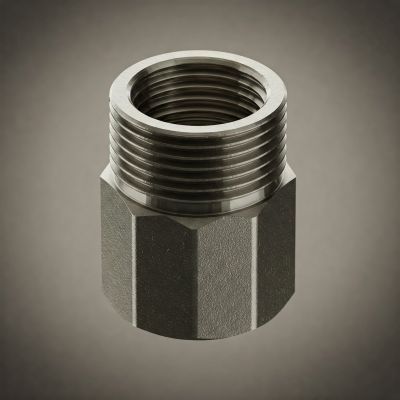Pipe threads are essential components in various industries, ensuring the secure and leak-free connection of pipes and fittings. Among the different thread types, understanding National Pipe Straight (NPS) threads is crucial.
This guide will delve into the specifics of NPS threads, their characteristics, and how they differ from other common thread types, particularly NPT (National Pipe Tapered).
What Is NPS Thread?
NPS stands for National Pipe Straight. As the name suggests, NPS threads have a parallel profile, meaning the thread diameter remains constant along its length.
NPS threads are governed by the ANSI/ASME B1.20.1 standard. Unlike NPT threads, NPS threads do not rely on thread interference for sealing. Instead, they require the use of gaskets, O-rings, or thread sealants to create a leak-proof connection.
NPS vs. NPT: What’s the Difference?
Thread Profile & Angle:
➡️ Both NPS and NPT threads utilize a 60-degree thread angle.
➡️ Key difference: NPS threads are straight, while NPT threads are tapered. This taper in NPT threads creates a mechanical seal by forcing the threads together as they are tightened.
Sealing Mechanism:
➡️ NPT threads rely on the taper to create a tight seal.
➡️ NPS threads require the use of gaskets, O-rings, or thread sealants to prevent leakage.
Applications:
➡️ NPT is primarily used in pressure-tight applications where the thread itself provides the seal.
➡️ NPS threads are typically used in structural and low-pressure applications where a separate sealing element is employed.
Interchangeability:
➡️ NPS and NPT threads of the same nominal size are not interchangeable due to the significant difference in their thread profiles. Attempting to use an NPT fitting with an
➡️ NPS pipe, or vice versa, will result in improper sealing and potential leakage.
Common Applications of NPS Threads
➡️ Low-pressure fluid transport: Used in applications where pressure is relatively low, such as in certain irrigation systems and low-pressure plumbing lines.
➡️ Railings and conduit pipes: Often used in the construction of railings, fences, and for supporting electrical conduit.
➡️ Mechanical connections: Employed in various mechanical assemblies where a secure, but not necessarily pressure-tight, connection is required.
➡️ Fire protection systems: Found in some fire sprinkler systems and other fire protection equipment.
➡️ HVAC: Used in certain HVAC applications, particularly where low-pressure air or water flow is involved.
➡️ Flanged fittings: Frequently used in flanged connections where a gasket provides the primary sealing mechanism.
How to Identify NPS Threads
Measuring Thread Diameter:
➡️ Use calipers to accurately measure the outer diameter (OD) of male threads and the inner diameter (ID) of female threads.
Checking Thread Pitch:
➡️ Use a thread pitch gauge to determine the number of threads per inch (TPI).
Comparing to Thread Charts:
➡️ Refer to standard pipe thread charts and compare the measured dimensions to the specifications for NPS threads.
NPS Thread Selection Guide
When to use NPS instead of NPT:
➡️ Applications where low pressure and minimal leakage risk are acceptable.
➡️ Situations where a separate sealing element (gasket, O-ring) will be used.
➡️ Applications where cost and ease of assembly are prioritized.
Best sealing methods:
➡️ Choose appropriate gaskets (e.g., rubber, PTFE) based on the application and fluid being transported.
➡️ Ensure proper thread preparation and the use of suitable thread sealants.
Industry recommendations: Consult industry standards and best practices for specific applications to ensure proper thread selection and installation.
Conclusion
NPS threads are crucial in various industries, providing a reliable and cost-effective solution for connecting pipes and fittings. Understanding the key differences between NPS and NPT threads is essential for proper selection and installation.
By carefully considering the application requirements and using appropriate sealing methods, you can ensure the integrity and longevity of your piping systems.
Always consult with a qualified engineer or refer to relevant industry standards for critical applications.
Post time: Feb-14-2025


